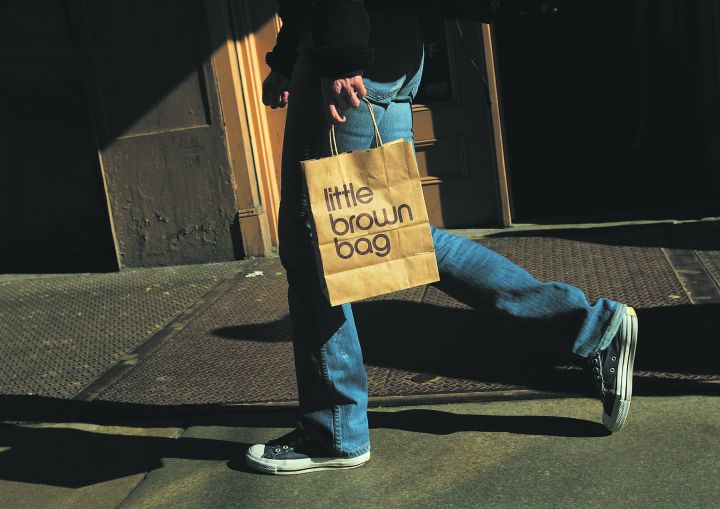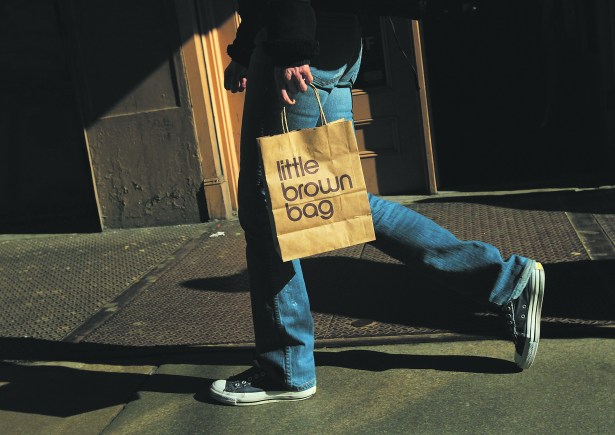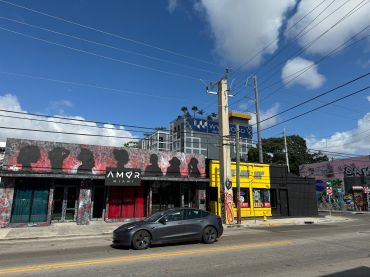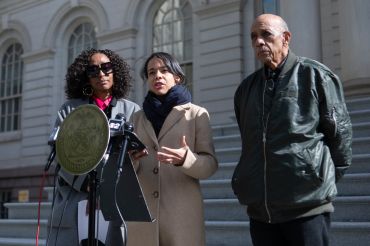Bargain Binge: A New Wave of Discount Department Stores is Hitting the City
By Danielle Schlanger May 18, 2015 12:19 pm
reprints
Since 2010, New Yorkers have been sitting shiva for their most beloved discount retailers; in 2011, Filene’s Basement shut its doors in Union Square and on the Upper West Side. The following year, Daffy’s closed eight of its Manhattan stores after it filed for bankruptcy. And last year, Loehmann’s bid adieu to the loyal following it had amassed since it opened in Brooklyn in 1921.
Even though it appeared that the discount designer store was a vestige of the past, a surprising phenomenon has happened over the past year: these stores are being replaced. And upgraded, by their high-end competitors.
Today, bargain-hunters can peruse the racks at Last Call by Neiman Marcus at 210 Joralemon Street in Downtown Brooklyn (the company will open a flagship full-priced Neiman Marcus at Hudson Yards on the Far West Side in 2018). Saks Fifth Avenue announced it plans to open an “Off-Fifth” outlet store at 1 Liberty Plaza in Lower Manhattan in 2017. Bloomingdale’s announced a new outlet store will open at 2085 Broadway on the Upper West Side this fall. And it’s not just the luxury department stores that have embarked on bringing department store discounts to New York. In February, Macy’s announced that it would debut its “off-price business” called Macy’s Backstage, with four stores in the greater New York area opening later this year.
“We’re in the midst of outlet and discount mania in New York City, and shoppers looking for that legendary buy can do so with greater convenience,” said Faith Hope Consolo, the chairman of Douglas Elliman’s retail leasing and sales division.
These discount stores offer shoppers drastically reduced prices compared to those of the goods sold at their main department stores. Last Call by Neiman Marcus boasts that shoppers can save as much as 65 percent off designer prices (and given the merchandise sold at Neiman Marcus, the savings could easily mean hundreds of dollars per item). Saks Off-Fifth says its customers have discounts of up to 70 percent off on the 800 designer brands the store carries. And the goods carried at Macy’s Backstage can be found for 80 percent off the original retail price.
Given the demise of its competitors and the exorbitant New York City rents affecting all retailers, the trend of department stores opening discount chains may seem counterintuitive. Yet discount stores are effective ways for department stores to expand their brand while opening a viable avenue for new revenue. Richard Hodos, a vice chairman with CBRE’s New York tri-state region retail services team, said that for Bloomingdale’s, the opening of these big-box discount stores is a move to ensure customers don’t flock elsewhere.
“What’s going on in America is that the middle-class is disappearing,” he said. “The top 1 percent doesn’t really represent a whole lot of people. There are not a lot of them in terms of quantity, and [these stores] want to protect their turf.” Because Bloomingdale’s targets an upper-middle-class shopper that today is likely feeling pinched financially, the store doesn’t want to lose them to cheaper retailers.
Bloomingdale’s new location on the Upper West Side (first reported by CO) is capitalizing on the void left by Loehmann’s. Its new location on Broadway, replacing an Urban Outfitters, will be steps away from where Loehmann’s once lured the frugal but fashionable. The store is designed to target millennials and broaden the Bloomingdale’s customer base. According to a press release issued by the company, the Upper West Side location will be the 14th Bloomingdale’s Outlet store and the first in a major urban center.
Macy’s, which targets a middle-class consumer, is also fearing the loss of valued customers. “[It] doesn’t want to lose shoppers to TJ Maxx and Target,” Mr. Hodos said. “It is creating another entity to keep them in the fold … as the middle-class is getting squeezed.”
According to Jim Sluzewski, a spokesman for Macy’s, the “Backstage” initiative is part of a strategy by the department store to grow its business in a new direction. The four off-price outlets will each be roughly 30,000 square feet. But Mr. Sluzewski noted that these four pilot stores will have to be tested before the company will decide if, or how, the initiative will evolve.
For Neiman Marcus and Saks, Mr. Hodos explained, expansion of their luxury department stores is a difficult business.
“Neiman’s is under a lot of pressure from its ownership [pushing for profit],” Mr. Hodos said. “You can’t add that many full-priced Neiman stores. St. Louis doesn’t need a second Neiman Marcus.” The Last Call model provides a vehicle for growth where the main department store does not.
In recent years, Saks has closed a number of its full-priced stores, including one in Portland, Ore., and one in Pittsburgh, Penn.
“New York and Florida is really the strong geography for Saks,” said Mr. Hodos, adding that the company has struggled in other markets.
But it is important to note: running a discount store, regardless of whether a company is backed by capital and resources, is no easy feat.
“It’s like running a discount airline,” said Mr. Hodos. “It’s a very difficult business.”
These stores, which are still considered big-boxes but are small compared to a full-line department store, are unable to afford high rents due to very thin margins. Mr. Hodos said that the model works best when companies are paying $30 to $60 per square foot. However, outside of New York, these discount models can’t even pay a fraction of that. Merchandise has to be moved quickly and efficiently from the manufacturer to the store.
Part of what led to the death of Daffy’s and Loehmann’s was losing access to vendors, a problem that will not happen with the companies that work with these merchants for their main department stores.
“[These stores] didn’t have the same ability to purchase goods that a Macy’s [does],” said Mr. Hodos. Adding insult to injury, these stores were not particularly well capitalized. Two bad seasons, he recounted, put Daffy’s in the red. Loehmann’s filed for bankruptcy several times.
However, there is proof that discount stores can survive. Value-oriented TJ Maxx, Marshall’s and Century 21 have figured out a model that has so far worked in New York.
“The Century 21 guys are the catalyst,” said Patrick Breslin, the executive managing director of the New York office of Colliers International. “They understood that people needed and wanted to buy luxury brand items but weren’t willing to pay luxury prices for it.”
Moreover, there is no longer a fear that discount stores will cannibalize their full-priced counterparts.
“I don’t think there’s a risk for overlap between the full-price store and the off-price store,” said Andrew Mandell, the chairman of the retail committee at the Real Estate Board of New York and a managing partner at Ripco Real Estate. “There is room in the city now for both of them.”
Ms. Consolo also believes that none of the department stores, from the new Nordstrom and Neiman Marcus to Bloomingdale’s, should be hit economically by the opening of offshoots targeted at cost-conscious shoppers.
“It won’t hurt the mother ships—we simply have so many people, there’s more than enough room for everyone,” she said.
Both Mr. Mandell and Ms. Consolo are alluding to the city’s demographic trends, which appear to be ripe for retail. Last year, New York welcomed 56.4 million visitors, many of whom capitalized on the incredible breadth of stores the five boroughs have to offer. Last month, New York YIMBY reported that the city is close to reaching what was projected to be its population in 2020 of nearly 8.6 million residents. Demographers suggest that the city should brace itself for when it inevitably reaches the 9 million citizens mark.
However, Ms. Consolo stressed that in most cases these stores are more than an arm’s length from their flagships. Neiman Marcus’ Last Call is in Brooklyn, far from the new Hudson Yards development. Bloomingdale’s Outlet Store will open across Central Park from the department store (which Ms. Consolo was quick to point out is “practically like opening in New Jersey.”) Macy’s Backstage pilot stores will open in Sheepshead Bay, Brooklyn and Elmhurst, Queens, with two other locations opening on Long Island. The one exception to this rule is Saks Fifth Avenue, which will have its new Downtown location at Brookfield Place only half a mile from Manhattan’s first Off-Fifth outlet at Liberty Plaza.
Retail is also regarded as a valuable amenity in a city whose neighborhoods are continuously evolving. This is reflected in where department stores are setting up their discount shops.
“Last Call is just a testament to the transformation that’s going on in Brooklyn,” said Mr. Mandell, referring to the borough’s wild popularity. The same could arguably be said about Off-Fifth’s location in Lower Manhattan; with Downtown’s resurgence and evolution into a 24/7 community, there is space for more retail players.
From a real estate perspective, the expansion of these chains has helped occupy the space vacated by big-box stores that have not survived, including Circuit City and Borders. (Ms. Consolo referred to these retailers as the “not-so-dearly departed.”)
“It’s a win-win,” she said.
So will the new Bloomingdale’s outlet on West 72nd Street survive steps away from where Loehmann’s met its end? Mr. Hodos says it remains to be seen.
“Bloomingdale’s has historically been a New York store,” he said. “It has the name Bloomingdale’s. They’re expert merchants. The people running Bloomingdale’s are very smart people … and [it] has Macy’s, Inc. behind them.” (Bloomingdale’s is owned by Macy’s, Inc.)
While it is all but impossible to predict how the influx of discount department stores will affect established players, Mr. Hodos expects that there will continue to be a large New York market for these goods, but perhaps with fewer players.
Here, Mr. Hodos sees a parallel between the discount retailers and the big-box stores.
“With the discount stores, there’s over-proliferation,” he said. “The strong ones will survive. The weak ones won’t be around. Staples has emerged as the dominant player in the office market. Petco is the dominant player in the pet market. A dozen years ago, there were five or six players in that market.”
Consolidation, Mr. Hodos said, is likely as more merchants continue to dive into the same pool.
“Just how there is in the auto industry, we’re still driving cars. There’s still Ford, Chrysler, GM. We just don’t have Pontiacs around anymore. It’s the same thing in retail.”



